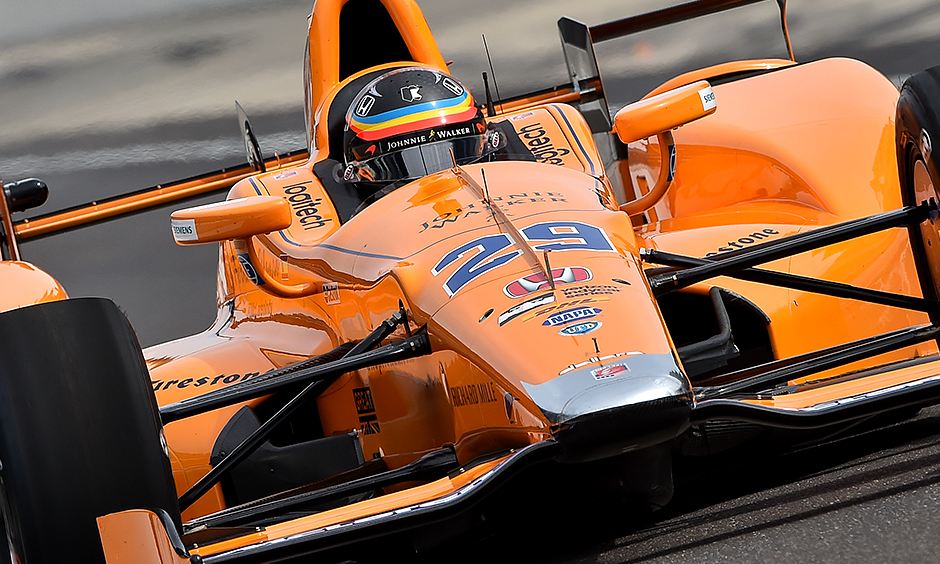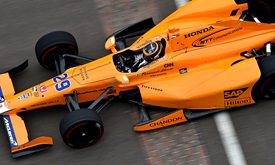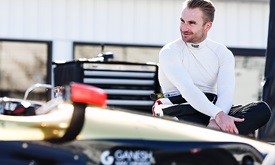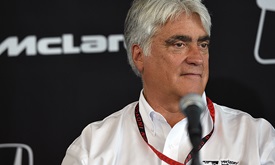Alonso learns that IMS oval test is anything but for the birds
MAY 04, 2017
Fernando Alonso prepared for turning his first laps at Indianapolis Motor Speedway by watching film of previous Indianapolis 500 rides as well as spending extensive time in a racing simulator.
What the two-time Formula One world champion from Spain couldn’t have foreseen in Wednesday’s test on the famed 2.5-mile oval was running into birds.
He swerved his No. 29 McLaren-Honda-Andretti away from one bird, but couldn’t miss two others a short time later.
“I didn't (see) that one coming,” Alonso said. “I saw one bird approaching Turn 3 in the penultimate run, and I just lift off (the accelerator) and avoid the bird. Probably I will not do that on the race day. But today I save one life there. I didn't manage to save the other two; that apparently they came out of (Turn) 1. But those ones, I didn't notice.”
His papaya orange machine hit both birds on opposite sides, the puff of flying feathers unmistakable in an otherwise smooth day in which Alonso passed his rookie orientation test with ease for the 101st Running of the Indianapolis 500 presented by PennGrade Motor Oil on May 28.
Alonso, 35, satisfied his rookie orientation within 51 laps. After consulting with Andretti Autosport CEO Michael Andretti, advisors Mario and Marco Andretti as well as 2003 Indy 500 winner Gil de Ferran, engineer Eric Bretzman and chief mechanic Dave Popielarz, Alonso turned 59 more laps before calling it a day amid light rain shortly after 3 p.m. ET. His best lap was 222.548 mph.
Mario Andretti, the 1969 Indy 500 winner and owner of 52 career Indy car victories as well as a Formula One world title, was so impressed by Alonso’s adaptation, he thought the rookie looked like he had been running at the track for two decades.
“The last two, three weeks, we've been through many of the things that I was probably facing on this first day, and now we have a lot more things to go through after this test that will be much more useful,” Alonso said. “Because at the moment, we only watch races on television and we saw data on the simulator, which you always are not 100 percent sure if you can trust or not until you test the real car.
“So I think now, we have a lot more things in the pocket that we need to go through.”
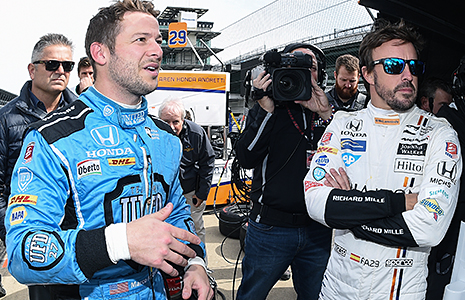 Marco Andretti set up the car with a pair of short runs and then reminded Alonso not to be confused by the road-course path when exiting pit lane to enter the oval.
Marco Andretti set up the car with a pair of short runs and then reminded Alonso not to be confused by the road-course path when exiting pit lane to enter the oval.
“I was making sure he didn’t pull a (Tomas) Scheckter and end up on the road course coming out of pit lane,” Marco said.
Alonso will return to his F1 commitment in the Spanish Grand Prix on May 14 before flying back to Indianapolis for the next day, the opening practice for the Indy 500. In his time away, he’ll study Indy 500 film more intently, now that he has a frame of reference from being on the iconic track.
“Yeah, we watch all of them again,” Alonso said. “Because now, definitely the track, it's (more) narrow than what I thought. You watch the television, and you see three cars aside on the main straight, and now you are with the (one) car on the main straight, and it's hard to imagine, you know, how you can fit three cars there and at that speed.
“Definitely, you will see some of the moves and some of the things that you were watching before in a different perspective, in a different way. So I will rewatch everything. I have some planes to take, some hours on the flight to watch.”
When he returns for practice, the biggest challenge in his assimilation will be to account for other cars in traffic. Whereas F1 cars race on road and street courses at lesser speeds with typically 20 entries, Alonso can expect to see as many as 32 other cars on track at IMS during practice and in the race.
“Well, it's going to be probably the biggest challenge, running on traffic,” he said. “I think there are a couple of things that I'm definitely not up to speed. One is the traffic thing, I think we need to go step by step. Today was just running alone and try to feel the car, the circuit and all the things that are involved with this technique.
“Second will be setting up the car. The guys, they make constant changes to the car. One on the steering wheel while running, and those on the pit lane, those tiny changes, tuning the car perfectly on the week for the qualifying and then doing the same on the race, and sometimes also on the pit stops, getting up to speed until the last part of the race. So on that aspect, I am not up to speed. I am not able at the moment to feel the car or the small changes that we can make to the car, because I'm not driving the car; the car is driving myself around at the moment.”
Alonso reiterated the allure of driving in the Indy 500 at this famous venue. He recalled his first visit to IMS in 2001 for Formula One’s U.S. Grand Prix, when he took pictures of the track entrance.
“What is different now is in my excitement (for) the race itself,” he said. “I am, you know, very excited about the race, but now that I test the car and I drove the car, I'm much more focused and concentrate on the work in business than the whole thing.”
As he prepared to go flat out and drive as free as possible, he realized Marco Andretti had turned laps flat out into Turn 1. But Alonso couldn’t help but back off the first time he entered that turn at what he thought was full speed.
“So I arrived to Turn 1, and I was convinced 100 percent that I was doing flat out, but the foot was not flat out, you know, as is in life, it was not connected, my brain with the foot at that moment,” Alonso said.
“So at the second or third lap, I was able to do it. But in the first lap, it was definitely a very good feeling, to be able to feel the respect of the place, the respect of the car, the respect of the speed. It's something that for any racing driver, it's just pure adrenaline, so it was a good day.”
Watch Alonso's post-test news conference here:
For more information about Honda Racing, visit http://hpd.honda.com/.










